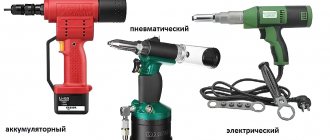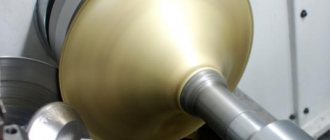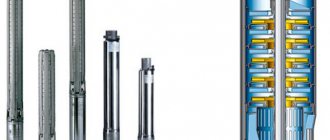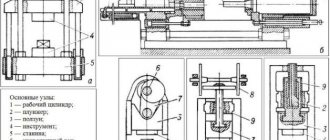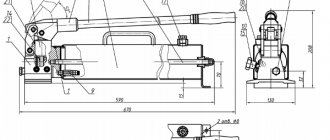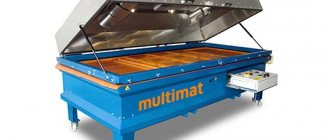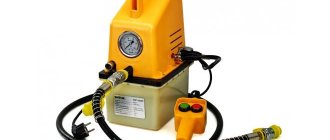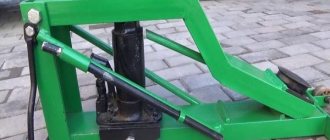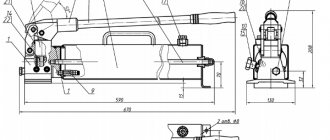Today, not a single large production enterprise can do without the use of pressing equipment, with the help of which a large range of technological operations can be performed. If, as a rule, powerful press installations are used to equip large production enterprises, then the best option for such equipment for home use (as well as for use in small workshops) is a manual press. A tabletop manual press, despite its compact size, also allows you to perform many technological operations with parts made of various materials.
Tabletop hand presses are very popular among home craftsmen
Scope of use of the device
The table press can operate on automatic or manual traction. The popularity of such a device is also explained by its particularly small size. Which is very important given the high rental price for production purposes. This equipment can be called truly durable, as it is made of hardened steel. Such equipment can operate for about 10 years without replacing component mechanisms, as well as without making additional repairs. Its operation does not require consumables, and the maintenance of such a machine can be entrusted to even the most unskilled and inattentive employee in the enterprise.
Using a hand press you can process the following materials:
- Cardboard.
- Skin.
- Foam rubber.
- Plastics and polymers.
- Various types of materials.
- Rubber.
Mechanical presses are actively used in all areas of production activity for pressing plastic containers, paper, various non-ferrous metal waste, aluminum, metal shavings, as well as other waste after production. This type of press is commonly used in printing houses, restaurants and hotels. The press will significantly reduce the costs of waste disposal.
Installation rules: secrets of specialists
The assembly of metal-plastic pipes using press connections is not technologically difficult. Before starting work, clear the area of debris and dust.
To work you will need tools:
- Pipe cutter For metal-plastic material this is the best option. When cutting such a pipe with a hacksaw, you will not encounter any particular difficulties, but the cut will be unsuitable for installation. you will need to additionally chamfer both sides of the cut, align the cut geometry to the correct circle, and remove all burrs. When using a pipe cutter, you will get a cut of the desired quality without additional processing.
- If you used a hacksaw or other improvised tools to cut the pipe, then you will need a gauge. This tool will straighten the circle and remove the chamfer.
- Press tongs (manual) or electric press machine. For one-time work on small sizes, you can get by with hand tools.
The connection to the crimp sleeve is made according to the following scheme:
- a press sleeve is placed on the outer part of the pipe;
- insert the fitting inside, pushing it all the way;
- crimp the sleeve with pliers.
When using a sliding sleeve, the procedure is as follows:
- a press sleeve is placed on the outer part of the pipe, moving it away from the edge;
- use an expander to increase the diameter of the pipe, insert the fitting all the way (without expansion, the pipe will not fit onto the fitting of the part with a sliding sleeve);
- Using special pliers, pull the press sleeve onto the pipe with the fitting and crimp it.
- The pipe should be cut for each section sequentially during the work, this will allow you to avoid getting confused in the finished sections;
- The fitting is crimped once; repeating this operation will lead to damage to the part;
- The chamfer can be replaced with sandpaper and a sharp knife;
In the summer, work can begin immediately, regardless of where the purchased materials were stored. In winter, you will have to wait several hours for the material to warm up to room temperature. The best solution is to bring in the pipes, fittings, and tools in the evening and leave them to warm up and dry the condensate overnight.
Design and operating features
All processes can be divided according to the shape of the rod into the following:
- Screw.
- Rack and pinion.
The design of desktop equipment that operates using manual traction is quite simple:
- Rack type rod.
- The bed is column-shaped, which is combined with a stand for placing a workpiece or a turntable.
- Specialized shaft.
- A gear train that is driven by a screw or lever.
The principle of operation of such a mechanism is that with the help of manual traction, the general rotational movement of the eccentric is launched. At the same time, it is attached to a piston, which efficiently presses the raw material through a special matrix. With all this, the force of counterpressure should be regulated by the very shape of the matrix , which can be easily replaced with a new one. There are a large number of matrices for different types of raw materials. In addition to this machine, there are special dies for the production of flat components from sheet metal.
When creating a structure, you can use various matrix schemes:
- Spinning.
- Hexagonal replaceable.
- Point replaceable.
Manufacturing materials
Wood or stainless steel is usually used to produce such devices. The latter option is valued for its practicality and ease of use. These cold-press juicers are easy to clean and leave no traces of raw materials on them. Wooden containers, on the contrary, absorb juice and change color. You can only wash them with a brush - and still, over time, the pigment from the berries and vegetables will be absorbed. If the wood is not completely dried, it will absorb foreign odors and mold may appear.
To be fair, it is worth noting that stainless steel is also not flawless. If processed poorly, it can interact with the acids of the raw materials, giving the final product an unpleasant taste. But even if we put this argument aside, for many people the tree is closer simply because it is familiar. It is more pleasant to work with and has been used for many generations. Another advantage of the material is its naturalness.
Tree
Stainless steel
Device characteristics
The main characteristic that will mainly determine the application of the press: maximum reinforcement in the area of the rod. In this case, the indicator can vary between 450-5 thousand kilograms. To create an auto repair shop, a pressure of 2 tons is enough, for use in a personal plot - 500 kilograms.
In addition to all this, the very size of the working area and the reach of the rod itself are considered important - it is on them that the dimensions of the manufactured parts will depend. The more powerful the machine, the more it will weigh and the more difficult it will be to lift. So, with the process of increasing the force by one ton, the weight of the device begins to multiply by two. The higher the power rating, the larger the mechanism itself and with the greater number of components it can function.
- Effort (varies from 500 to 5 thousand kilograms).
- The total cross-sectional area of the rod (the larger the area, the larger the product itself can be made).
- The height of the total workpiece (from 10 to 25 centimeters and depends on the range of the rod extension).
The desktop type of product is considered more stable, durable and reliable, and it will also be much easier to work with such equipment. Changing parts in it is quite simple, the parts at this time will come out quite accurate. Accuracy in performing the work will be ensured by the overall rigidity of the structure, as well as the monolithic body.
In conclusion
A self-made hydraulic press has a number of undeniable advantages:
- The simple and inexpensive design will please you for a long time.
- The model does not have various types of safety devices for rebooting, which simplifies the model.
- The operation of the device is not affected by the position of the work table.
- You can safely change the parameters of the height and length of the working stroke.
Today it is impossible to imagine a garage or car service without hydraulic equipment. By making the press yourself, you will receive exactly the device that will serve you for a long time. In conclusion, we would like to offer you a video to clearly see the intricacies of home production of a hydraulic press.
Types of hand presses
To use the press in different industries, the following types of manual presses are created:
- Hydraulic. The required force occurs using a hydraulic cylinder rod. The hydraulic cylinder itself contains a certain working fluid, which begins to actively compress under pressure to create connections, compression, and deformation of the shape of objects. It is considered more powerful and of higher quality than a manual mechanism: it is capable of creating tens of tons of force with the slightest effort on the part of the employee.
The main component of the design is a pair of hydraulic cylinders in various sizes, which are filled with technical oil. They operate between themselves using a working fluid. The operating principle of such a device will be very similar to a mechanical one, only in this case a special technical oil is used in place of the lever. The power of the equipment will be directly proportional to the ratio of the diameters of the cylinder and piston.
- Hole punching. A special type of press for stamping holes in sheets of various types of materials, including metal no larger than 4 mm. The total diameter in the punched surfaces will vary from 10 to 40 mm.
- Manual mechanical press. It is used mainly for crimping cables and tubular sleeves. Crimping is the most reliable method of connecting electrical cables; it increases the overall current conductivity, which reduces resistance and prevents overheating in the cable, reduces the possibility of accidents during the production process, as well as burning of individual connections. It is most effective to perform crimping using a mechanical hand press.
This mechanism is presented in the form of a lever, equipped with ratchets or ratchets; they prevent the development of reverse motion and create a fairly strong force so that high-quality adhesion occurs in the wires. The design allows you to easily change the total length of the arms. The pressure that occurs in the equipment can be compared with that provided by a hydraulic analogue , but the second one has a significantly higher cost. To achieve high-quality compression in the wires, you should press the handle several times, and then change the included nozzles.
A mechanical press can work with electrical wires of absolutely any cross-section up to 240 sq. mm. When choosing equipment, it is worth clarifying its operating range. The larger the device, the thicker the cable it can crimp.
- Press jaws. Used for putting lugs and sleeves on special cables and electrical wires. In this case, such a device creates a special press-type profile. Capable of working with a maximum cable cross-section of about 35 square meters. mm. The total weight of the instrument at this time will be three kilograms.
- Tablet press. This is a special device that is designed to create tablets in the laboratory. There are a large number of modifications of tablet devices, including tabletop ones, which perform their work using manual traction. The total productivity in such a device varies from 200 to 1 thousand tablets per hour.
The diameter of the tablets is created by a certain shape in the range from 0.4 to 1 centimeter, the thickness is no more than half a centimeter. The maximum gain will reach 700 kilograms. Laboratory tablet devices can be of the hydraulic type, and also perform work from an electric motor. Such devices will be more powerful , the productivity per hour will be about 6 thousand tablets.
Easily installs buttons and is not afraid of thickness! + about lubrication and force adjustment
I have long wanted to put buttons on clothes that would open easily, just like on baby clothes. How many of these bodysuits and slips I had, they all opened in one motion and without effort, and only once or twice did the fabric tear around the button. But when I bought buttons and pliers on Ali, the picture was completely different. ok, the pliers were basically bad at installing the buttons, but I tried to install them with a hammer, but the force to open was still high.
Now I know it's the Turkish or European buttons! In general, it depends more on the fittings than on the tool; I tried using both Chinese and Turkish buttons. They are indistinguishable by appearance, they seem to be exactly the same in size, and are installed in the same way, but they work completely differently. The size of the buttons is the same between these and the Chinese ones, that is, you can take a Chinese press (I don’t mean the KAM press, they are good, but they themselves are expensive, and the attachments for them), but the reviews for Turkish presses are better. I have Mikron, there are several other brands, but the difference, judging by the articles and videos, is insignificant. I chose a press with nuts on the back, with their help you can adjust the force. This is where there was originally another nut:
Press selection criteria
- Power indicator. The clamping force in a manual type mechanism will directly depend on the effort on the part of the person. A hydraulic device is considered more complex and powerful, and therefore does not require a person to apply any increased effort; a hydraulic press is considered more powerful and complex in structure, and does not require too much effort; the effect at this time is achieved due to a special design.
- Size indicator. The size of the device is considered a fairly important indicator; it will be especially important for small production points. At the same time, the smaller the device, the fewer parts it will be able to perform work with. A small desktop device can cover the needs of workshops or households. If you are going to do work with large parts, then you should choose a larger unit. In most cases, these perform their work hydraulically.
- Purposes of use. Presses are mainly used only in production or during installation. There are special models for the production of food products, for example, juice. Such drugs are in most cases used in home production.
Homemade press from a jack with your own hands: drawings and diagrams
For some operations, a home craftsman may need a press with significant compression force, but purchasing equipment of this class will be completely unjustified. Today we will tell you how to assemble a reliable press based on a hydraulic car jack in a few hours.
What and how to assemble a frame for the press?
The material for the frame, its structural strength and the method of assembly should be determined by the pressure that the jack is capable of delivering. For accurate calculations, it is important to understand in which direction the loads act during operation.
The base of the press is a rectangular U-shaped frame made of a channel or a paired steel angle. The main acting force is the resistance to compression, expressed in concentrated load. The main force is concentrated in the centers of the horizontal crossbars. The forces that stretch the vertical racks of the press and the phenomena of deformation in compressed parts can be completely neglected.


